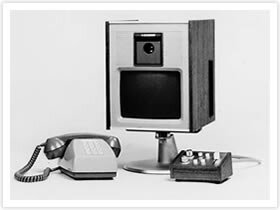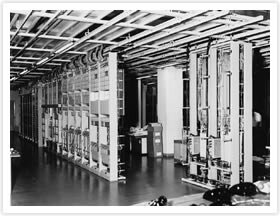part 9
Part 9: Providing core technologies to advance the development of an electronic switching system
In April 1967, Nippon Telegraph and Telephone Public Corporation ("NTT") announced its Ten-year Vision for Telegraphs and Telephones. The proposed electronic switching system, one of the new core technologies required to achieve this vision, attracted significant attention. OKI vigorously pursued its unique groundbreaking research and prototype development, as well as participating in a national project led by NTT's Electrical Communication Laboratories ("ECL") to commercialize the electronic switching system. Within this project, OKI played a pivotal role in the area of semi-fixed storage devices.
Contributing to joint development efforts to produce a domestic electronic switching system

In 1967, the year after the total number of telephones in use in Japan reached 11,180,000, the world's second-highest total, NTT announced a Ten-year Vision for Telegraphs and Telephones, a step toward the future information society. This vision projected a society ten years into the future and presented various specific technological advances, such as mobile communications systems for use in aircraft and automobiles, widely-used portable and push-button phones, and televisions in classroom settings. An electronic switching system was considered an essential element for achieving these goals. In 1968, as a first step, NTT launched its fourth five-year plan to expand the telegraph and telephone system.
ECL immediately launched a national project for the joint development of an electronic switching system. However, against a backdrop of continuously emerging new elements, such as diodes, transistors, and ICs, development activities fell into disarray. Then came news that the United States had successfully commercialized the world's first electronic switching system. The core system developed in the U.S. used a stored program control system, differing fundamentally from the system being considered in Japan.
A stored program control system controls the execution of predetermined functions, using processing functions stored in a storage unit. This technology was borrowed from computing. The engineering team at OKI in charge of developing a semi-fixed storage device for the project reviewed the technology while considering cost issues. Eventually, it proposed a stored program control system that used metal card memory developed by ECL for program storage and core memory for temporary storage. This moved the joint research project to the next stage.
Advances in the development of Japan's electronic switching system
In 1964, NTT chose to adopt the stored program control system and announced a 10-year plan to commercialize the electronic switching system. This plan called for the development of a prototype—DEX1—for laboratory experiments, by the end of fiscal 1966, followed by the development of DEX2, a prototype for field testing. The plans set fiscal 1973 as the target period for commercial application based on the results of comprehensive verifications. This helped organize development activities for the electronic switching system being undertaken independently at that time by various companies, thus adding momentum to the joint research project.
Plans progressed smoothly. OKI oversaw the manufacture of small crossbar switches for use in the DEX2 channels. Unique and different from comparable approaches, the design concept for this device drew significant interest worldwide.

A problem emerged as the project shifted to the next stage, the development of a more economical DEX21. The metal card memory used for program storage proved unable to handle the frequent program changes required by commercial applications. This problem was eventually resolved by using wire memory developed by OKI, which offered excellent interchangeability and cost-effectiveness. It continued to be used as a storage device in units manufactured after the DEX21.
Ensuing research on commercializing the electronic switching system led to the completion of the D10, a commercial unit. In December 1969, OKI established an Electronic Switching Promotion Department. Despite limited experience in the area of central control systems, OKI vigorously pursued research, making full use of its expertise in memory devices. In October 1971, OKI delivered the D10, Japan's first commercial electronic switching system, to the Yodobashi Telephone Office in Shinjuku, Tokyo. This marked the beginning of the era of electronic switching systems in Japan.
OMNIPAX: Taking the electronic switching equipment market by storm

Leveraging the technologies accumulated in the development of the D10, OKI ventured into the consumer product market. At that time, with the oil crisis underway, the industry was entering a period of sluggish growth. In this economic climate, OKI released the OMNIPAX electronic switching system in 1976. This was an innovative product created by combining the technologies for consumer electronic switching systems with technologies drawn from input/out devices, modems, and transport equipment, which gave OKI the reputation as the Device Manufacturer.
Around this time, companies operating offices and factories across the nation began using fax and data communications in addition to telephones as part of daily business activities, increasing their communication costs. Naturally, this encouraged most companies to seek ways to minimize communication expenses and reduce operating costs. OKI's OMNIPAX was well-received, since the product used dedicated networks to dramatically reduce phone charges compared to public telephone lines.
Said Masaaki Yamamoto, OKI President at that time: "Providing products that meet customer needs and contribute to society at a time of economic recession bolsters OKI's very existence." It is no exaggeration to state that OMNIPAX filled this purpose.
